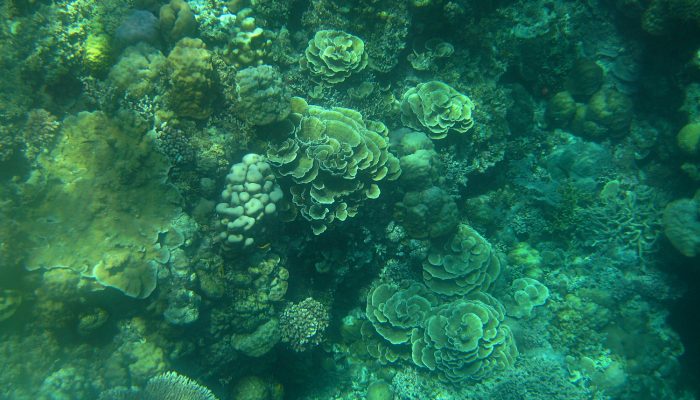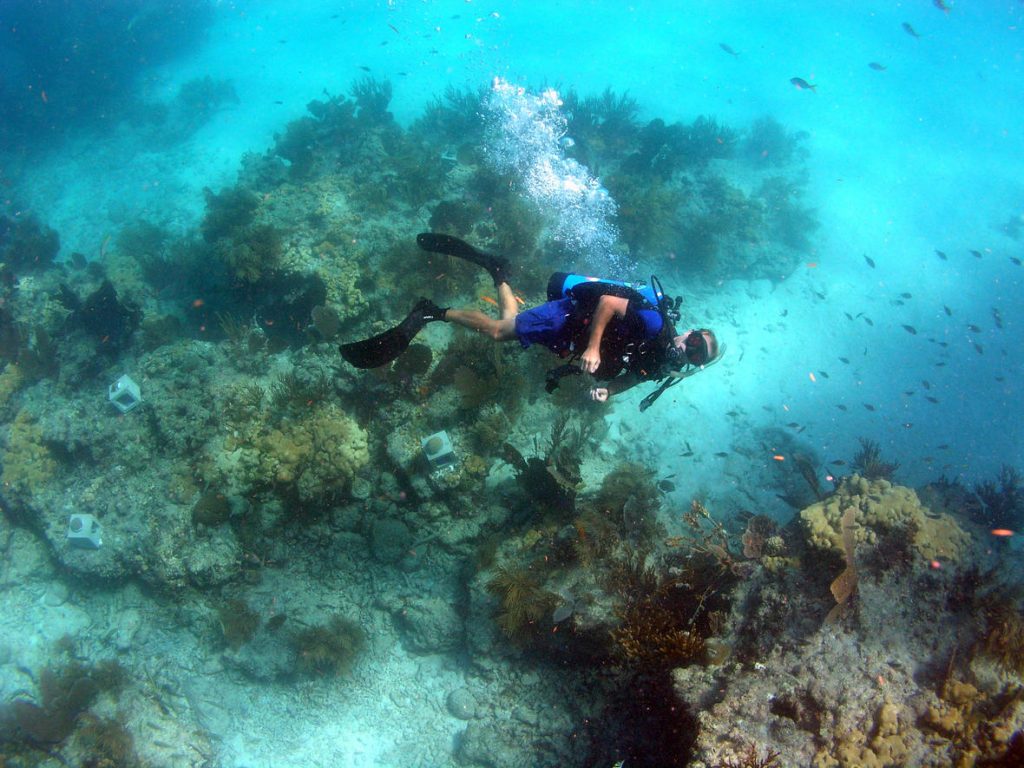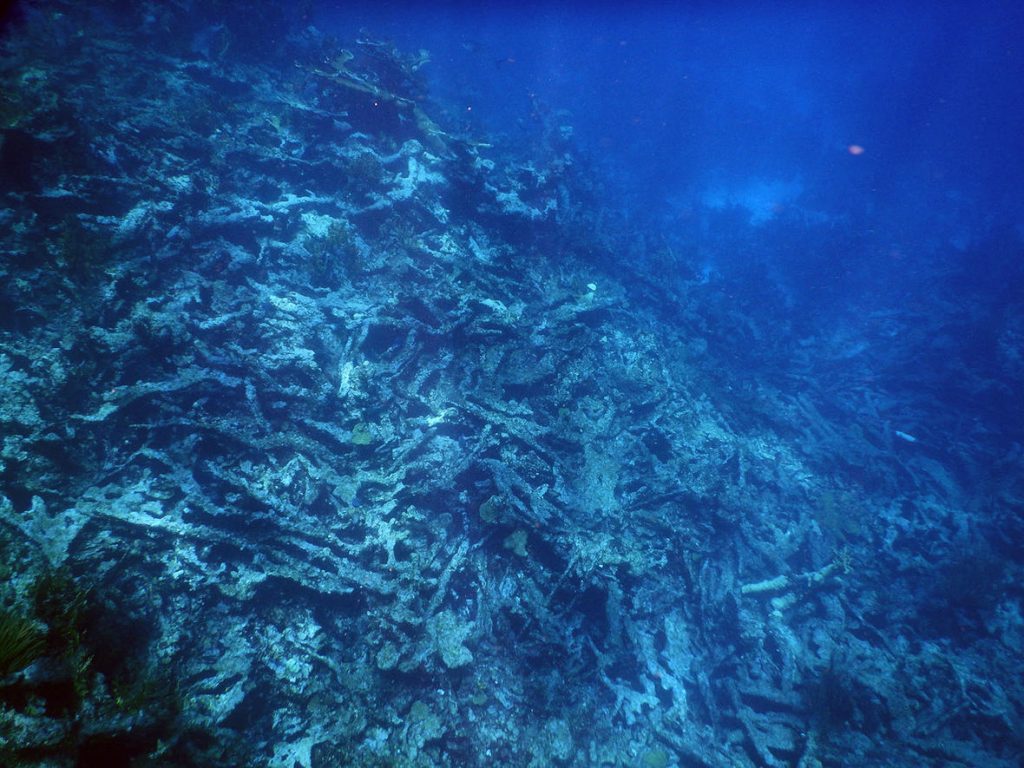
The world’s oceans cover 71% of the Earth’s surface and contain 97% of Earth’s water. They play a key role in the climate cycle and, though perhaps not always visibly, are suffering significantly under our changing climate. An place where we can see the alarming effects of rising temperatures and increasingly acidic waters is coral reefs, which experienced the longest, most widespread, and possibly the most damaging coral bleaching event on record between 2014 and 2017. In today’s post, Heather Britton compares natural vs. artificial coral reefs in the context of protecting life below the water (UN sustainability goal 14).
Reefs around the world are dying – approximately half of the world’s coral reefs have disappeared over the past 30 years, and many are showing signs of following in their stead – be it due to increased water temperature, sea level change or an influx of sediment in previously nutrient-poor conditions. Many of the factors contributing to the bleaching and eventual death of these ecosystems stem from the impact of people, such as global warming and the development of resorts in the vicinity of fragile reef environments.
The disappearance of coral reefs would lead to a catastrophic loss of biodiversity – coral reefs are thought to be the most biodiverse ecosystems on the planet, displaying a greater variety of life than even rainforests, and it is clear that we need to act now if these environments are to be saved – for many reefs it is already too late.
One popular response to the loss of natural coral reefs has been to construct artificial reefs, replacing those that have died and providing a habitat for organisms that may otherwise become extinct. These structures take a plethora of forms, from sunken ships to cinder block stacks, but as long as they are made of a hard substrate and are able to offer protection and a place for sheltering organisms to spawn there is potential for a reef to develop in as little as two-three years.
In many ways, this is an elegant solution. Not only do artificial reefs help to combat the loss of biodiversity associated with the decline of their natural counterparts, but they attract divers and other tourists to the sites where they are placed, bringing in tourism and strengthening the economy in the area. This benefit is particularly valuable to lower income countries, some of which boast extensive coral reef ecosystems. In addition, reefs are known to concentrate fish populations and therefore are popular with the fishing industry worldwide – the first recorded artificial reefs were developed by fishermen in Japan in the 18th century, who sunk makeshift shelters to increase their haul. Reefs form from man-made substrates relatively easily, and they are certainly preferable to a lack of reefs altogether – but can artificial reefs really ever match their natural cousins?

Diver installing ocean-chemistry monitoring equipment at Florida Keys. Credit: Ilsa B. Kuffner (U.S. Geological Survey). Distributed via U.S. Geological Survey.
Artificial reefs are created extensively off the coast of Florida, as much for the economic benefit that the tourism brings (both through fishing and diving) as increasing ocean biodiversity. The region is encountering problems, however, one of which is local people choosing to develop their own personal reefs using suboptimal materials. For example, tyres, when strapped together, attract aquatic organisms as they provide a place to spawn and the shelter of a natural reef, but the toxicity of the rubber can negatively impact the environment in ways that a ship or concrete blocks will not. Ships that are sunk professionally for the purpose of artificial reef formation are extensively prepared before they are placed underwater, whereas amateurs rarely take the time to prepare their seeding structures properly. This has led some countries, such as Australia, to develop laws against the formation of artificial reefs without a permit.
Artificial reefs are also celebrated because they attract divers away from the surviving natural reefs, meaning that each individual reef is less damaged by people. It is also possible, however, that the number of tourists in total might increase in response to the increased number of dive-sites, having the opposite effect and causing dive sites in the region to become more popular.
Arguably, the most important question to be asked when discussing natural vs artificial reef structures is: do artificial reefs have biodiversity equivalent to that of natural reefs? The answer is unclear, but it certainly seems that the biodiversity of each kind of reef is different. Artificial reefs, at first glance, seem to attract more fish to them than natural reefs. This suggests that that artificial reefs may be encouraging fish to reproduce more than the naturally occurring reefs scattered throughout the oceans. However, many of the marine animals attracted to feed and shelter around artificial reefs do not breed there, and simply visit from other regions of the ocean. Artificial reefs therefore may only be acting to concentrate the fish in a single area, making them more susceptible to fishing and generally increasing the effect of fishing pressure on marine populations. This is commonly referred to as the ‘aggregation vs production’ debate. If the fish are more numerous at artificial reefs because they are breeding there, then the reef is likely acting to increase the population of that particular fish species and artificial reefs are helping to sustain the biodiversity of the oceans. If they are simply concentrating fish that typically spend their time swimming between reefs, however, fish numbers are likely to be negatively, not positively affected.

Dead corals turned to rubble, off the coast of the US Virgin Islands. Credit: Curt Storlazzi (U.S. Geological Survey). Distributed via U.S. Geological Survey.
A study on the Caribbean island of Bonaire provides some insight into the differences in diversity between natural and artificial reefs. Equal diversity was found at partnered artificial and natural reefs, but the composition of this diversity was starkly different. Whilst the sergeant major and bluehead wrasse fish were most commonly seen on the artificial reef, the natural was more commonly frequented by bicoloured damselfish and brown chromis. Similar trends were visible within the benthic community of organisms, suggesting that although artificial reefs may preserve the diversity that we see within the oceans today, some organisms appear to populate natural reefs to a far greater extent than their artificial counterparts, and these species may still be lost.
For this reason it is of the utmost importance that every effort is made to protect the natural coral reefs of today, thereby working to achieve UN sustainability goal 14 (Life below the Water). Artificial reefs are helping to preserve the biodiversity of the oceans and save countless organisms from extinction, but it is important to remember that what causes the corals of natural reefs to die will also impact the corals which begin to grow on artificial reefs. In order to prevent the loss of these ecosystems we need get to the root of the problem and combat the things that are harming coral reefs – global warming, human physical destruction of reef environments and the pollution of our oceans.




